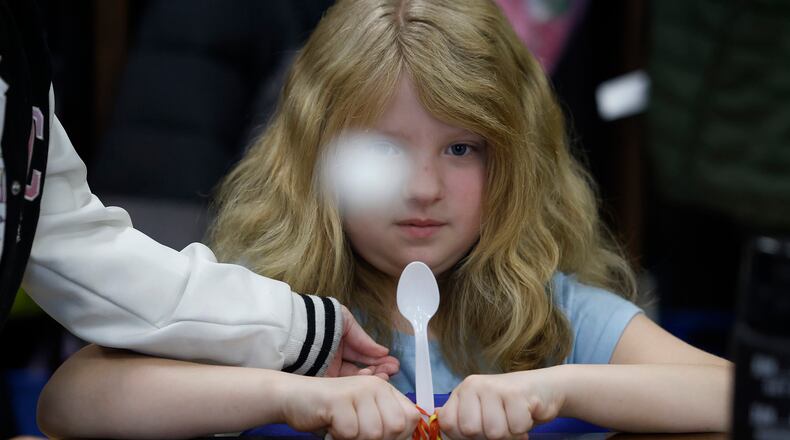A photographer and I had to carefully step around the recently thrown gummy bears the kids were using to measure the power of their handmade catapults. The kids were competing to see how far they could fling a gummy bear using handmade catapults, trying to get the gummy bear to go at least 10 feet. By the end of the lesson, they’d all met the goal.
Carey is the district’s STEM — science, technology, engineering and math — elementary school coach. His job, created this school year, is to go to different classrooms and help the teachers think of creative ways to incorporate STEM projects into their regular lessons.
It reminded me of when I visited Jessica Lay’s classroom in Miamisburg earlier this year. But rather than a dedicated weekly class to STEM, Carey’s goal is to get the teachers in Xenia to incorporate STEM programming in their regular classrooms.
At the end of the lesson, Carey asked how many students had to try more than once to get their catapult to work. All but one group raised their hands. One group that remade their catapult four times also consistently threw their gummy bear the furthest.
“The more times you go through and make it better, the better it would be,” Carey said.
Carey started in Dayton Public Schools before moving to Xenia and has taught for 22 years. His STEM background is also extensive: he’s worked with the Department of Defense as a STEM ambassador, and he just took a position as a STEM fellow with the National Science Teacher Association. Besides coaching other teachers, he also runs drone, 3D printing and robotics initiatives in the district.
“One of the big district goals is student engagement,” Carey said. “So kids wanting to be in school, wanting to be in class, wanting to learn, wanting to do things. And we see STEM as a great mechanism for engaging kids in learning.”
The kids were engaged when I was in the classroom, catapulting gummy bears and cotton balls through the air. There weren’t any kids who were sitting to the side or seemed disengaged. Carey said he had one parent tell him her kid was throwing up and still wanted to come to school because of the project Carey was planning in their classroom.
It’s more than just a fun activity, though. Asking kids to solve a problem, like throwing a gummy bear on a handmade catapult as far as they can with limited materials, teaches them problem solving, Carey said. Measuring how far each gummy bear went is a math skill. Putting the kids in pairs teaches them to collaborate and communicate. Those are all skills that employers say they want in their employees. Instead of trying to teach those skills at a high school level, they’re being introduced at younger ages.
Carey said STEM has already gotten a lot of buy-in from the teachers in Xenia schools. So far this year, he’s been in 70 of the district’s 100 elementary school classrooms. In another of Xenia’s elementary schools, the teachers are planning to read a book and do a classroom STEM activity around it in December, without Carey’s input, which is what he’s trying to achieve.
“You can’t do a project like this every single day, it’s too much,” Carey said. “But to make this a regular part of how we learn, is the big goal.”
Carey ran out of his startup materials and said he’s waiting for a grant to come through so he can buy a new round of materials. The district is paying for Carey’s salary, but he’s looking for grants and donations to pay for some of the more expensive materials, like robots or computers.
Because his position is new, it’s something that could continue to grow and change, said Kristy Creel, the district’s communications director.
“This is year one, so this is what it looks like now,” Creel said. “But what it looks like in two years, three years, five years, it can just keep growing and evolving.”
About the Author



